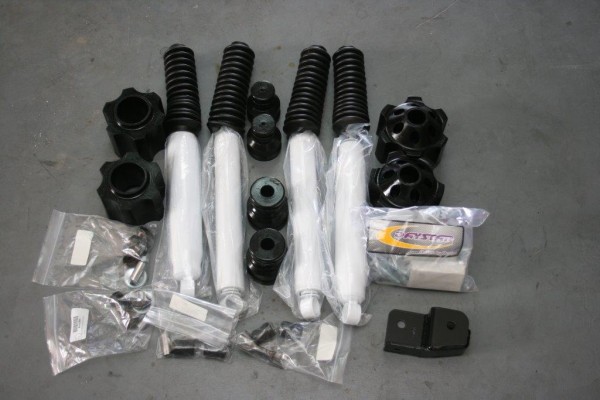In our opinion, Jeep should include a three-inch lift and 33-inch tires in the JK Wrangler Rubicon option package.
After all, this package already includes a heavier-duty transfer case with 4:1 low range, heavier-duty Dana 44 differentials with 4.11:1 gears, selectable lockers, and a front sway bar that can be disconnected from inside the cab.
So why not include even larger tires and a lift as well?
Those of us who enjoy Jeeping the way it’s meant to be enjoyed want a Rubicon. We love to explore and camp in the backcountry, and the maroon four-door JK is perfect for that—except for the scraping, screeching and sliding over the rocks on any moderately challenging trail. To remedy the problem, we decided it was time to lift and upgrade the tires on my 2008 Wrangler Rubicon Unlimited.
Fortunately, we found the ideal solution in the form of a Daystar three-inch lift kit for 2007 to 2013 JKs. Daystar’s lift kits use three-inch high polyurethane spacers, plus four Scorpion shock absorbers to help improve suspension damping. There’s no metal-on-metal contact—Daystar uses polyurethane material as an insulator to absorb the noise, vibration, and harmonics that come from the suspension and avoid transmitting them to the passenger compartment. Plus, the kit is covered by a lifetime warranty.
Using the Jeep’s original equipment coil springs, we expected the ride to be exactly like that of the original Rubicon. However, we were pleasantly surprised to find the Jeep actually has a better off-road ride with the Daystar kit, and there’s no change in the on-road ride that we could notice. The longer Daystar Scorpion shocks seem softer initially (so the smaller bumps and ruts aren’t felt as much as before) and then they dampen down on the bigger dips, rocks and ridges in a progressively stiffer manner. The only other addition to the JK was a set of taller, heavier-duty Toyo Open Country M/T LT285/75R17 tires (approximately 34 inches in diameter).
Daystar’s instructions are top-notch and include a list of the tools you’ll need. A second floor jack really helped with raising and lowering the axles during the installation while the Jeep was supported with jack stands. You may need some pry bars and very large screwdrivers as well. Make sure to follow Daystar’s step-by-step instructions in numerical order—the results are well worth the effort!

























Daystar’s lift and leveling kits are constructed of high-density polyurethane … I run this kit on my Jeep and I love it everything I needed to install this kit on my JK.
[…] Download Image More @ http://www.onallcylinders.com […]
[…] Download Image More @ http://www.onallcylinders.com […]
[…] Download Image More @ http://www.onallcylinders.com […]
[…] Download Image More @ http://www.onallcylinders.com […]